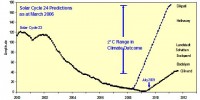Guest Post by David Archibald on Watts Up With That
NASA’s David Hathaway has adjusted his expectations of Solar Cycle 24 downwards. He is quoted in the New York Times here Specifically, he said:
“Still, something like the Dalton Minimum - two solar cycles in the early 1800s that peaked at about an average of 50 sunspots - lies in the realm of the possible.”
NASA has caught up with my prediction in early 2006 of a Dalton Minimum repeat, so for a brief, shining moment of three years, I have had a better track record in predicting solar activity than NASA.

The graphic above is modified from a paper I published in March, 2006. Even based on our understanding of solar - climate relationship at the time, it was evident the range of Solar Cycle 24 amplitude predictions would result in a 2C range in temperature. The climate science community was oblivious to this, despite billions being spent. To borrow a term from the leftist lexicon, the predictions above Badalyan are now discredited elements.
Let’s now examine another successful prediction of mine. In March, 2008 at the first Heartland climate conference in New York, I predicted that Solar Cycle 24 would mean that it would not be a good time to be a Canadian wheat farmer. Lo and behold, the Canadian wheat crop is down 20% this year due to a cold spring and dry fields. Story here.
The oceans are losing heat, so the Canadian wheat belt will just get colder and drier as Solar Cycle 24 progresses. As Mark Steyn recently said, anyone under the age of 29 has not experienced global warming. A Dalton Minimum repeat will mean that they will have to wait to the age of 54 odd to experience a warming trend.
Where to now? The F 10.7 flux continues to flatline. All the volatility has gone out of it. In terms of picking the month of minimum for the Solar Cycle 23/24 transition, I think the solar community will put it in the middle of the F 10.7 quiet period due to the lack of sunspots. We won’t know how long that quiet period is until solar activity ramps up again. So picking the month of minimum at the moment may just be guessing.
Dr Hathaway says that we are not in for a Maunder Minimum, and I agree with him. I have been contacted by a gentleman from the lower 48 who has a very good solar activity model. It hindcasts the 20th century almost perfectly, so I have a lot of faith in what it is predicting for the 21st century, which is a couple of very weak cycles and then back to normal as we have known it. I consider his model to be a major advance in solar science.
What I am now examining is the possibility that there will not be a solar magnetic reversal at the Solar Cycle 24 maximum. Read more and comments here.
Icecap Note: The sun is quiet again for going on 3 weeks. A reader suggested a more accurate source of annual sunspotless days here. It had some additional years in the late 1800s with over 150 spotless days. The current string of spotless days since the flurry of activity early in July is 23. That brings the total for the year to 165. That is just ahead of the 163 in 2007 and in a tie with 1996. It puts us in 18th place now in the period since 1850. Last year in this data base we were still ranked 4th highest since 1849 but with 265 spotless days. If we continued to have spotless days on 77% of the days as has been the case the first 7 months of 2009, we would top last year. In any event we should reach the top 10 at least. Also the only other three successive years in the top 20 were 1911, 1912 and 1913.
This data base does not include the years before and during the Dalton Minimum. Larger image here.





